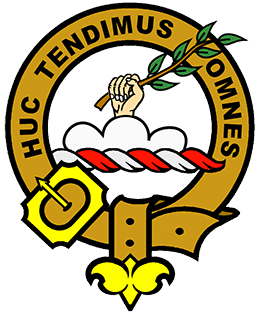Paterson Clan
Paterson Clan Crest: A dexter hand issuing out of a cloud holding a laurel branch, all Proper
Paterson Clan Motto: Huc Tendimus Omnes (We all strive for this).
Paterson Clan History: THE territory of Clan Pheadirean / MacPhaidraig was to be found on Loch Fyne during the 13th century, but the surname of Paterson which translates from the Gaelic “MacGille Phadraig,” meaning “a follower of St Patrick,” the Patron Saint of Ireland, is today scattered throughout Scotland. In the Highlands, the surname is closely associated with Clan MacLaren and Clan Farquharson.
In 1446, a William Paterson “Gentleman” witnessed a Charter in Aberdeen. Donald Paterson was admitted burgess of Aberdeen in 1494, while Patrick Paterson faced accusations of defrauding the king's customs in 1524. In 1544, Robert Paterson was documented as the commanding officer of a warship at Dundee and in the 1560's, and in 1576 James Paterson served as the Provost of Inverness.
The Paterson family owned Denmuir (Dunmore/Dunmoore) in Fife from the 1400's until the late 1700's. A carved oak plaque, bearing the Paterson arms, dated 1635, still exists on a steading at the estate. Captain Andrew Paterson of Denmuir had the arms with Huc Tendimus Omnes motto registered at the Lyon Court in the 1670’s. In 1702, his son, George Paterson, Baron of Denmuir, won the Silver Arrow archery competition medal, at St Andrews University.
The entrepreneurial William Paterson, a farmer's son from Dumfries, was one of the founders of the Bank of England in 1694, and the promoter of the disastrous Darien Scheme of 1698, which led to the bankruptcy of Scotland and the Act of Union with England in 1707. It was as a guest of Sir Hugh Paterson, 2nd Baronet of Bannockburn, in 1746, that Prince Charles Edward Stuart was introduced to Sir Hugh's niece Clementina Walkinshaw, who became his mistress and the mother of Charlotte, Duchess of Albany.
Associated family names/spelling variations: Patterson.
Surname distribution in Scotland: The Paterson surname is widespread throughout Scotland with the highest concentrations in the Lothians, Perthshire, Lanarkshire, Glasgow, Fife, Tayside, Aberdeen and Aberdeenshire.
Places of Interest: Bannockburn House, Stirlingshire. Bannockburn House was built in the 17th century by Sir Hugh Paterson whose son and grandson became baronets, taking the name of the house. In 1787, the house was sold to William Ramsay of Barnton and Sauchie, then to the Wilson and Mitchell families. The house remains under private ownership.
Castle Huntly, Longforgan, Perthshire. Imposing 15th century four-storey tower with garret, belonged to the Paterson family from 1777 to 1948. Now Scotland’s only open prison for low-risk inmates.
Myres Castle, Auchtermuchty, Fife. Z-plan tower house, dating to 1530. Owned by the Pattersons in the early 1600s. Now an award-winning luxury Scottish wedding venue.
Dura House, Pitscottie, Cupar, Fife. Privately owned Scots Baronial mansion house incorporating an earlier castle or house. Owned by the Patersons of Dura in the mid-1600’s
Old House of Carpow, Newburgh, Perthshire. Ruined T-plan mansion house, held by the Pattersons for over two hundred years.

